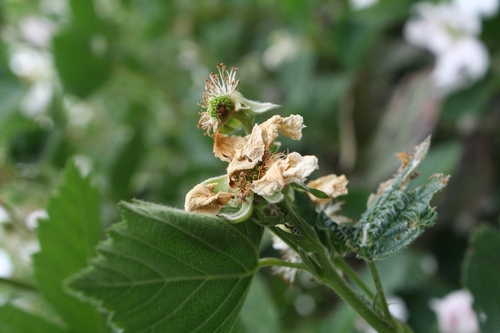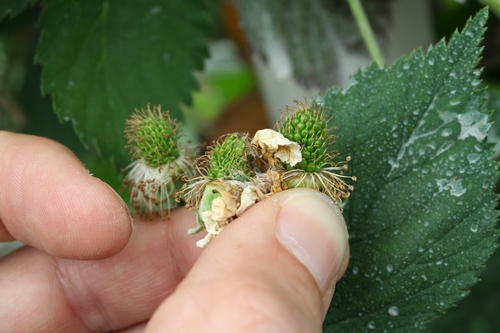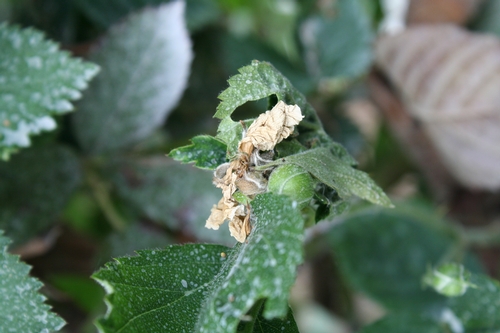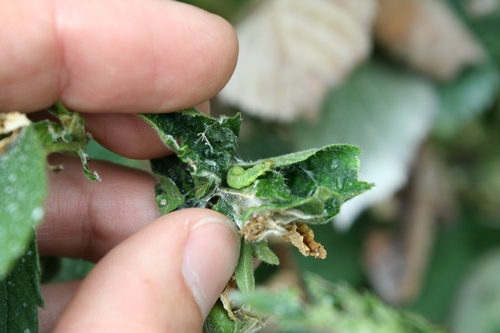
- Posted By: Mark Bolda
- Written by: Mark Bolda
I had a fruitful meeting with PPQ Supervisor Rick McKay, Inspector Leah Gayagas and currently serving Santa Cruz County Agricultural Commissioner Mary Lou Nicoletti on May 19. This meeting was concerning the current inspection and field closure procedures for light brown apple moth in strawberry and caneberry growers in the quarantine zone which covers all of Santa Cruz county and most of the berry production areas of North Monterey counties.
At the time of the meeting, three raspberry fields and one strawberry fields had been closed because of positive finds, so this matter is of considerable urgency to the berry growing community.
Inspections are to take place for each grower every thirty days, either at the cooler for those sending fruit there, or at the field for those growers who are sending fruit out of the quarantine zone venues such as farmer's markets and fruit stands. In addition to this, it is worth reminding growers who are growing fruit for export out of the USA that county phytosanitary inspections are also being done on every load, and they will forward suspect leafrollers to the USDA PPQ program.
Inspections are being done as before, that is to say that 2% of a designated load are evaluated for leafroller presence. If a leafroller is found in the load- and this means any leafroller species - a hold is put on the load and also on the field from where the load came. If no leafrollers are found, the field is clear for another thirty days. A suspect leafroller gets shipped up to the identification laboratory in Sacramento immediately via FedEx and a positive or negative determination should be available within one or two days of the find. If determined to be positive, the hold on the fruit and field continues, if negative then the hold on the fruit and field is lifted. As noted before however, if the larva is very small or is in the pupal stage, the determination will take longer, maybe up to a week and a half.
Field closure is done after an inspection of the field from where the infested load originated. Size of the closure is not arbitrary, it depends on where the larvae are. If they are in a corner of the field only, then only that corner will be closed. If they are spread evenly through the field, then the whole field will unfortunately be closed. Growers should be aware of the trend of finding more leafrollers along the edges of fields in wooded and riparian areas.
One key point out of this meeting for berry growers and their consultants is that once a hold is put on a field, it must be inspected for light brown apple moth larvae before being released. The date of inspection is negotiable, and it might not necessarily be in one's best interest to have a field inspected immediately, since if there are no larvae found, then the hold on the field is lifted and no regulated spray and subsequent field inspection necessary. So, it would seem a good thing for growers experiencing a load hold and subsequent field hold to get that field cleaned up right away. Arrangements can generally be made for inspectors to come out a few days after a hold is put in place, which would give the grower time to spray a fast acting material like a spinosyn and run a crew through and pick out leaf rolls. By doing all of this effectively, the grower avoids the burden of dealing with the regulated spray (and it's disappointingly short list of allowed chemicals) and follow up inspections. By moving quickly, the grower can avoid all that.
The attachment below is the USDA inspection protocol for fruit inspected at a cooler.
Mark LBAM090
- Author: Mark Bolda
There have been now two field closures over the past week in the Watsonville-Salinas berry production district, and the following is meant to make some sense to growers for what to do to minimize losses in the event of a leafroller larva detection.
USDA inspectors are not agriculturalists, nor pest managers for that matter. We in the industry should be aware that they are bound by a set of rules that at times may seem at odds with sound pest management, but it yet is incumbent upon us as professionals to work with them and come out with the best solution for both parties which is the elimination of leafrollers and re-opening of the field with as little impact to the normal management of the field as possible.
Growers should be aware that outside of the USDA inspections taking place monthly at each cooler, fruit sent for export out of the USA is being sampled and inspected by county personnel. They have long done this to look for pathogens and other insects and recently this repetoire has been including leafroller larvae. On finding a suspect larva, the county inspector forwards it to USDA inspectors, who will make an identification of the larva if possible at the cooler and also forward it on to the DNA identification laboratory in Sacramento. The process from find to absolute positive identification at the DNA lab is about a week, but can take longer in the case of very small larvae or pupae.
It appears that growers are advised of a possible LBAM find on the same day, and a hold is put on the source field. Inspectors will pay a visit to the hold field to find larvae, which they inevitably do. Now, the grower has the option of re-routing fruit from the field under the hold order to clients within the quarantine area or destroying it. Both have happened this last week. It is truly tragic when another market cannot be found for fruit, but such is the nature of this quarantine.
Once advised of the hold, arrangements are made to have inspectors observe a pesticide application of the infested field with the purported goal of controlling LBAM. In the interest of time, the process of arranging a pesticide application and field re-inspection is allowed to move forward even in the absence of a full positive identification for LBAM. Time of initial suspect LBAM find to time of observed spray seems to depend on a number of factors, but generally happens within a week.
In berries, the list of allowed pesticides for inspector observed, mandated sprays is unfortunately rather short. For strawberry growers, fortunately Intrepid, Entrust and several Bt formulations are included, but notably Coragen, Success and Radiant, which are highly effective and actually have light brown apple moth on their labels along with being pretty soft on beneficials and the surrounding environment, are not allowed. Instead, we are additionally allowed crude materials such carbaryl (7 day pre-harvest interval, pollinator caution, devastating to beneficials), and chlorpyrifos (21 day pre-harvest interval, seriously harmful to beneficials). A superior type horticultural oil is allowed, but only at a minimum rate of 1% volume to volume, which for a petroleum distillate is pretty risky in sensitive crops like strawberries or caneberries.
Once the approved pesticide application is done, arrangements are made to have the field re-inspected in the interests of confirming that it has been cleared of leafroller larvae and re-opening it. This is a rather important point for berry growers, because when this happens depends on what material that has been applied. Based on our experience, inspections have been taking place one day after an application of Entrust, and more than several days after Bt formulations. If you are willing to take a chance of burning your plants and fruit, the superior type oils also are supposed to give one day. Intrepid and Confirm as insect growth regulators (IGR's) are known to act more slowly so again garner a re-inspection after more than a few days.
It seems in light of all of the above, the strategy that berry growers should be taking in relation to leafroller management should be as per the following:
1- Keep fields clear of leafrollers. Period.
2- In the unfortunate event of a possible LBAM find and hold on the field, spray the field IMMEDIATELY with the very effective and labeled materials such as Coragen or Radiant in strawberries and Delegate in caneberries. By doing so, you are giving these materials time to act in full while you make arrangements for inspections and sprays with the USDA.
3- Make arrangements for mandated spray with the USDA.
4- Make application of Entrust since you should be able to get inspectors in the next day to confirm that it has cleared the field of leafrollers.
5- Undergo inspection from USDA to re-open field. Note that your spray of the better material from the day of the hold will now have taken full effect along with the effects of the Entrust, and you should by now have dramatically reduced, if not eliminated, leafroller larvae from your field.
There are pesticides mentioned for management of leafrollers and light brown apple moth in this article. Before using any of these products, check with your local Agricultural Commissioner's Office and consult product labels for current status of product registration, restrictions, and use information.
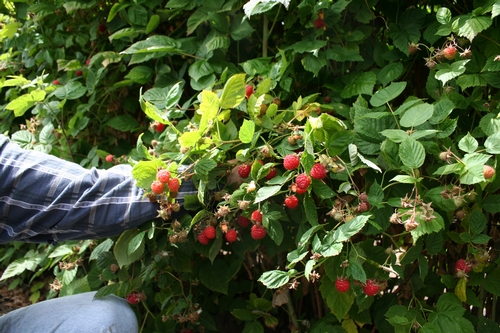
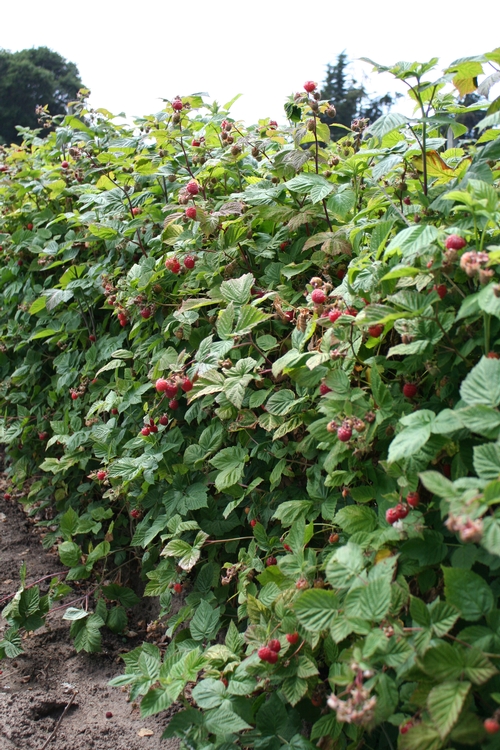
- Author: Mark Bolda
Since we have had our first field closure in strawberry as of last night, it is important for us all to review how the USDA regulatory process unfolds for growers here.
Field closure is expensive and to be avoided. For readers who are not growers or familiar with commercial strawberry production, consider that the average weekly take out of a field can be 400 boxes per acre that we will conservatively price at 8 dollars a box back to the grower. So the weekly cost of LBAM closure to a fifty acre field is 160,000 dollars. Personally speaking, this enormous penalty is totally out of proportion with the infraction of having a quarantined pest in one’s field, but it is not my decision to make.
Cooler Inspection: USDA inspectors are to visit area coolers at regular intervals, my understanding is that because of the reduced budget for the program they will be checking in at each local facility once a month. This may change however depending on the vagaries of Federal budgets and politics. Once at the cooler, inspectors take a subsample from a load of fruit from each production field for that day. The inspectors are VERY thorough, the field closure from last night came from a larva tucked under the calyx. Unfortunately, such a larva often cannot be identified right away and so a hold is put on fruit coming out of that field. In plain English, that means the field is closed and you can no longer harvest and send fruit out of that field.
Field Inspection: Once a field has been identified as possibly infested with light brown apple moth, the next step is for inspectors to do an inspection of the field itself. I have seen field inspection, and it does not leave one leaf unturned. For somebody with experience, leaf rolls are easy to see, and inspectors walk with up to six people abreast, one person per row. Since this is their job, day in and day out, they are really good at it and if you have a leafroller, it will be found.
Treatment of Infested Fields: If no leafrollers are discovered during the field inspection, the field is opened back up. If a leafroller is discovered and furthermore found to be positive for LBAM, the grower is mandated to make an application. He or she chooses from a list of allowed materials, and fortunately this year, according to program director Rick McKay, surfactants and adjuvants are allowed and highly recommended. All parts of the application are observed by inspectors from loading, mixing and the actual spray. Nothing says that the grower can't be making applications before and after this regulated application, but they need to see the one they mandate. Then, depending on the pesticide used, inspectors return after a specified number of days to re-inspect the field. If no more leafrollers are found, the field is opened back up. If a leafroller is found, the field remains closed and the application procedure is repeated. Experience from last year says more often than not it takes more than one spray to re-open a field. In some cases, especially in organic fields, which have a much narrower selection of effective materials, it can take more than a month to re-open.
Discussion: It is imperative that growers pay attention to leafrollers in their fields. Yes, they are around, because I have been getting phone calls about this all week long now. Conventional growers have a wide range of materials at their disposal, organic growers less. It is not a bad thing yet to be putting out the pheromone mating disruption twist ties, since we are probably looking at a flight of adult moths in late June, with a subsequent larval infestation in July and August again. In light of the devastating costs of field closure, it might not be too much to have crews go through the fields regularly and be removing rolls.
- Author: Mark Bolda
This is a revision from the previous post:
A couple of samples handled by this office from strawberry over the past two weeks have turned out to be a leafroller species which might not be light brown apple moth. Probably the reason people have been asking about these is the general concern about having leafrollers in one’s production field at all. This is understandable, considering the current regulatory environment which mandates closure of at least part of a field on discovery of one species of leafroller; the light brown apple moth. Fields can also be temporarily shut down as regulators work on distinguishing leafrollers from one another in order to get a positive light brown apple moth identification.
The following short description will be about garden tortrix in strawberry.
This very important for those making a definitive identification in the field. While the UC IPM guidelines refer to garden tortrix as having a "spot on the back of the head" this spot is actually a darkened prothoracic shield behind the head on not on it (see fourth picture below). I would very much like to get a definitive sample from our area of garden tortrix for a clear picture for this blog, so will ask my readership to bring any suspect samples. It would be very helpful.
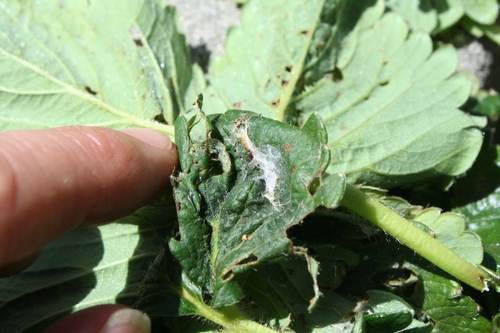
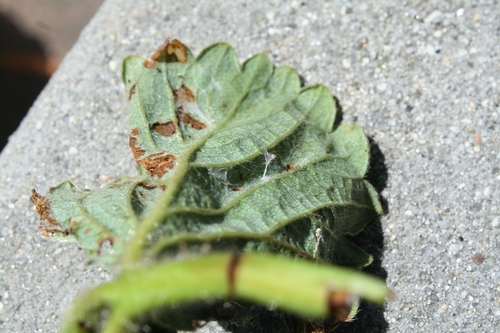
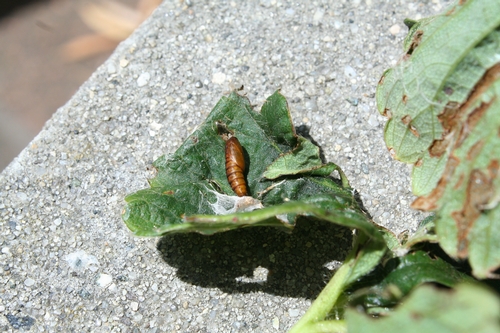
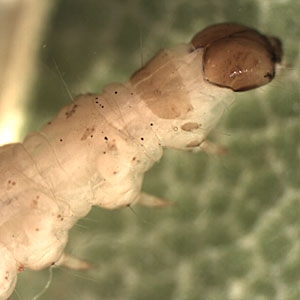
- Author: Mark Bolda
Blackberry growers in the Pajaro Valley should be aware that there are substantial numbers of light brown apple moth (LBAM) larvae active in many fields right now. The photos below outline what this pest looks like and what it is doing right now in our blackberry fields.
In the photographed field, there were on the order of 7-9 leafrolls per two feet of hedge in the heaviest infested areas and in excess of 80% of the leafrollers sampled in the photographed field were identified as having a very high likelihood of being LBAM. This is very concerning, since under the current quarantine enforced by the USDA, the presence of any leafroller in a field can be cause for significant delay of harvest much less outright field closure if an LBAM is found.
While clearly not the level of devastating 100% loss of harvest caused by field closure for a positive LBAM find, LBAM itself is also capable of causing some damage. As one can see from the photos below, damage ranges from incidental feeding on flowers resulting in blemished (thus unmarketable) fruit to heavier feeding causing abortion of entire laterals and the subsequent loss of fruiting potential there. In the field photographed below there was damage of some sort to one of every sixteen fruiting laterals.
Anecdotally, it appears that growers who kept up with changing out pheromone based twist ties every four to six months have very low populations of LBAM suspect leafrolls, while those who allowed pheromone coverage to expire before putting up a fresh set are tending to have heavier, in some cases very heavy, larval infestations. If one is not going to be using pheromone based twist ties through the entire year, it is at least a good idea to put out a few pheromone traps to find out when adult males are starting to fly and looking to mate so as to better target use of mating disruption techniques.
As it seems many of the larvae being discovered currently are in the fourth to late instar stage (½ to ¾ inches in length), applications of Bacillus thuriengiensis formulations will not prove to be very effective. Better materials are the spinosyns, one of which (Entrust) is registered for use in organic fields, and bifenthrin (hard on beneficials though). Addition of a good surfactant is always a good idea to break spray water surface tension to facilitate movement of material into even the tightliest wound leafroll.
There are several insecticides mentioned for control of light brown apple moth in this article. Before using any insecticides, check with your local Agricultural Commissioner's Office and consult product labels for current status of product registration, restrictions, and use information.
